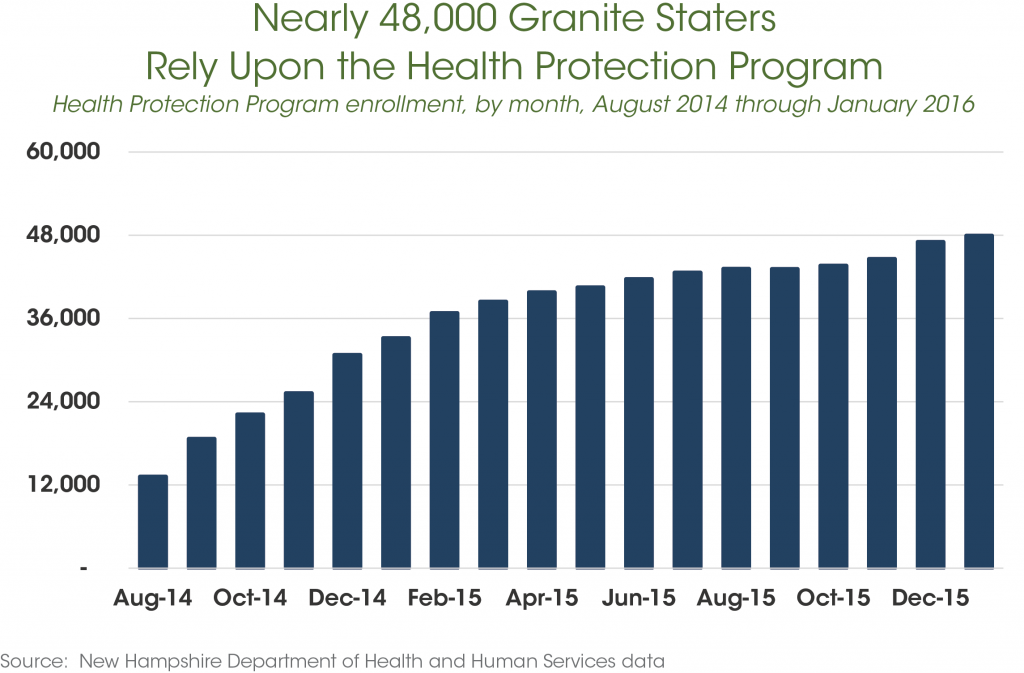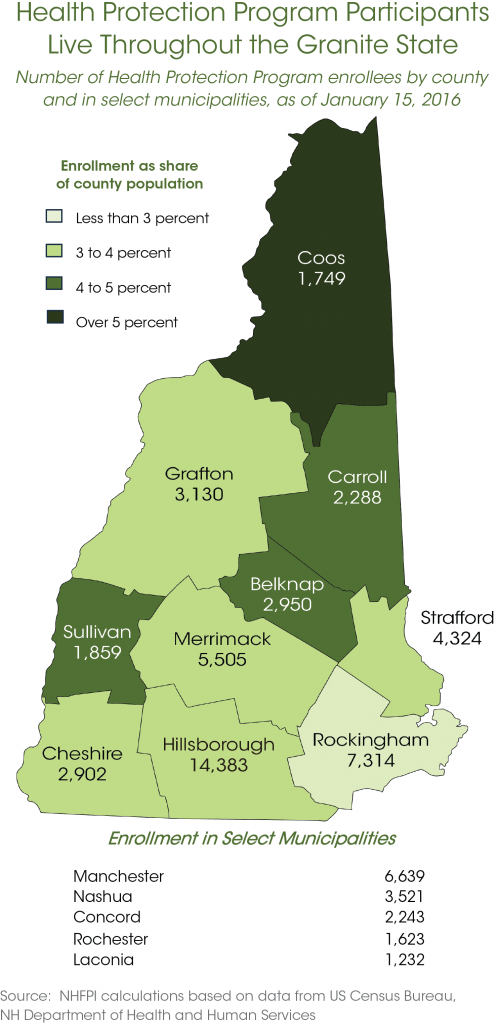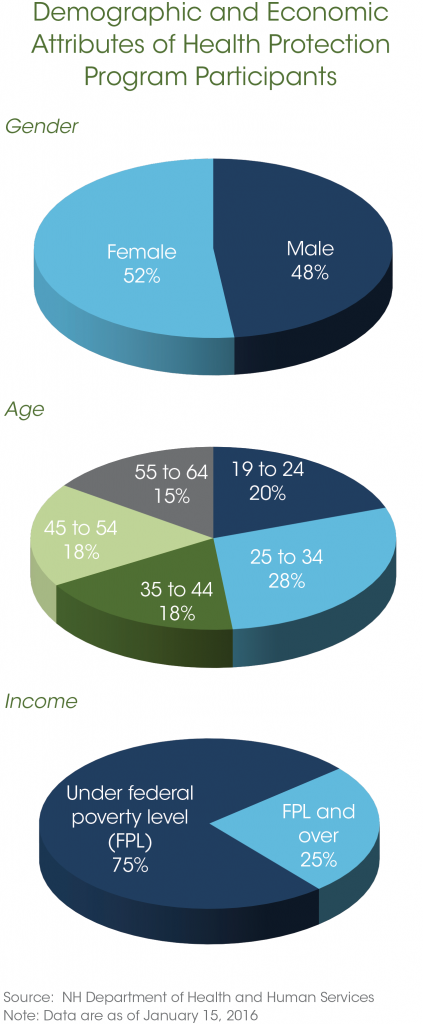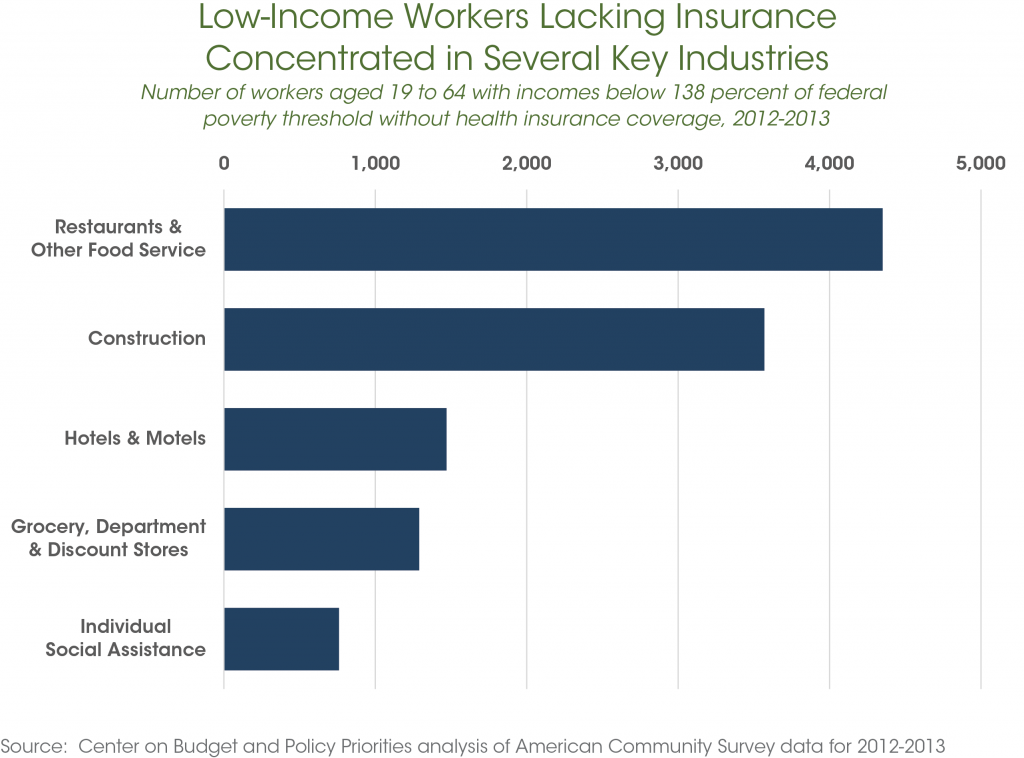Over the past 18 months, nearly 48,000 Granite Staters have enrolled in the New Hampshire Health Protection Program, improving their health and financial security and bringing hundreds of millions of dollars in federal funds into the state economy. Despite these advances, in the absence of legislative action, the Health Protection Program will expire at the end of 2016. If the Health Protection Program were to end, thousands of hardworking Granite Staters would lose the ability to see their doctor and the security of knowing they can get care when they need it. This Fact Sheet provides a brief description of the eligibility requirements for the program and background data on the people it serves.
Eligibility
To receive health care coverage through the Health Protection Program, an individual must be an adult aged 19 through 64 and must have a household income below 138 percent of the federal poverty level (FPL). For 2016, that means an individual must have an annual income below $16,243 to participate in the program, while a married couple would have to earn less than $21,983. In addition, low-income adults who would otherwise be eligible for New Hampshire’s traditional Medicaid program – for instance, due to a disability or a pregnancy – cannot take part in the Health Protection Program.
Enrollment
Enrollment in the Health Protection Program amounted to 47,904 Granite Staters as of the end of January 2016.[i] As the graph below illustrates, enrollment grew rapidly in the program’s earliest days, as efforts to promote awareness of the program took hold and low-income adults learned of their eligibility. Between August 2014 and March 2015, enrollment rose from 13,166 to 38,402, a monthly growth rate of nearly 17 percent. Since that time, enrollment growth has slowed considerably, to just over 2 percent per month on average. Of note, projections from the New Hampshire Department of Health and Human Services, included in the fiscal note for legislation to reauthorize the Health Protection Program (HB 1696), show enrollment averaging 47,500 throughout fiscal year 2017 and growing by about 2 percent per year in each of the three succeeding fiscal years.
Participants in the Health Protection Program live throughout New Hampshire, but, not surprisingly, are found in greater concentrations in counties and municipalities that have lower incomes and higher poverty rates. As the map at left indicates, most enrollees live in one the state’s three most populous counties; in fact, over half of all enrollees live in either Hillsborough, Rockingham, or Merrimack Counties. However, program participants comprise relatively larger shares of the population in Coos, Belknap, and Carroll Counties, each of which have fared less well than the state as whole in recent years. For instance, for the 2011-2013 period, New Hampshire’s overall poverty rate was 9.1 percent. In those three counties, the poverty rate equaled 13.0, 10.6, and 9.8 percent respectively.
Still, incomes are not the sole determinant of the geographic distribution of program participants; areas with higher intensities of employers that do not offer health care coverage to their employees may see a larger number of participants.
Those Granite Staters who depend upon the program for access to affordable health care are slightly more likely to be female and appear to be somewhat younger than the working-age population as a whole. [ii] Data from the New Hampshire Department of Health and Human Services reveal that approximately 52 percent of Health Protection Program participants are female, compared to 50 percent of the working-age population as a whole. At the same time, just under 29 percent of program participants are aged 25 to 34, while less than 19 percent of working-age Granite Staters fall in that age range. While definitive data on the causes of this disparity are not available, it may arise in part because of the types of employment in which younger New Hampshire workers are engaged.
Indeed, those workers enrolled in the Health Protection Program are most likely to be found in a handful of industries in New Hampshire. During the 2012-2013 period – that is, immediately prior to the creation of the program – approximately 39,160 adults aged 19 through 64 with family incomes below 138 percent of the federal poverty level lacked health insurance.[iii] Of that total, close to 25,000 had worked at some point in the year prior. In turn, nearly half of those workers were employed in just five industries; no other industry accounted for more than 3 percent of such workers. As the graph below indicates, chief among such industries were restaurants (where 4,350 low-income adults lacking health insurance worked during 2012-2013), construction (3,570 low-income workers without insurance), and lodging establishments such as hotels and motels (1,470 low-income workers without insurance).
Finally, as noted above, most Granite Staters between the ages of 19 and 64 with incomes less than 138 percent of FPL are eligible to participate in the Health Protection Program, but where their incomes fall in that range is still important, for at least two reasons. First, program participants with incomes in excess of 100 percent of FPL will, beginning January 1, 2016, be required to share in the costs of their coverage. That is, single people with incomes over roughly $12,000 and married couples with incomes above approximately $16,000 will face deductibles or co-pays for certain medical services. Second, adults with incomes below 100 percent of FPL are not eligible to receive subsidies to purchase health care coverage on the federal Marketplace. Consequently, if the Health Protection Program were allowed to expire, many participants would not be able to afford to purchase alternative coverage through the Marketplace. Data from the Department of Health and Human Services indicate that, in January 2016, more than 35,000 program participants – or three-quarters of the total – have incomes below 100 percent of the federal poverty level.
__________
[i] Except when noted, all data are from the New Hampshire Department of Health and Human Services.
[ii] Estimates of the gender and age composition of the New Hampshire working-age population are NHFPI calculations based on data from the 2014 American Community Survey.
[iii] The data presented here are based on a November 2015 analysis of data from the 2012 and 2013 American Community Survey conducted by the Center on Budget and Policy Priorities.




